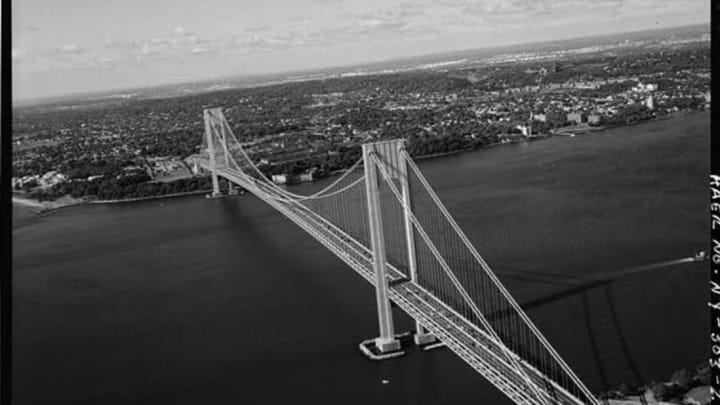Last night, on the eve of the 50th anniversary of the opening of the Verrazano-Narrows Bridge, Gay Talese joined former New York Times Metro columnist Clyde Haberman at the Museum of the City of New York to reflect on the four-year period during which he witnessed the building of the bridge.
The night opened with an introduction of the bridge: How it helped Staten Island grow from an enclave of farms to practically a city in its own right, with 470,000 people living there today; how the residents of Bay Ridge Brooklyn protested the disruptive construction with signs that read "Who Needs The Bridge?"; how it was the longest suspension bridge in the world for 20 years after it was built (it now sits at number 11, but remains the longest in the country).
"It doesn't make a difference to me how long it is," Talese remarked in his opening statements, emphasizing for the first of many times that he was interested in learning "who builds these things, who does the work?"

Museum of the City of New York
In his book, first published in 1964 and now re-released with an updated preface and afterword, The Bridge: The Building of the Verrazano–Narrows Bridge, Talese answers those questions of the human element, detailing the stories of the boomers (as he calls them)—the men who build bridges and skyscrapers. He knew them, and remembers them still, by name. Over the span of several years, he wrote at least a dozen stories for the Times on the construction, and between reporting those and going on his own time, Talese developed an immense respect and understanding of these workers. He would go with them to bars after work ("Six, or seven, or whenever the sun went down") and once even drove through the night with a group of Native Americans working on the bridge to spend the weekend with them on the reservation back in Montreal.
Among those Talese talked with at the time were James and John McKee, sons to a former ironworker who was permanently disabled after a collapsed crane sent him careening two stories to the ground, and brothers to the late Gerard McKee, the third and final man to fall to his death while working on the Verrazano-Narrows Bridge. One chapter of the book recreates the day of McKee's death in harrowing, intimate detail with the help of Edward Iannielli, a friend and fellow boomer who had tried unsuccessfully to hold onto the much-larger McKee as he slipped off the south edge of the catwalk.
Following McKee's death, the workers union went on strike, demanding nets be placed below the precarious workzones. After that, there were six more falls, none of them fatal. One man, Robert Walsh, fell twice; fittingly, Walsh is now the president of the ironworker's union, Talese told the audience at the Museum.
Walsh isn't the only former bridge-builder Talese visited on the occasion of the anniversary. He even called some of the former Brooklyn residents who opposed the bridge, those who were forced to relocate. "Most say 'we're better off,'" Talese reported. "I don't know if this is a minority opinion, but it's an opinion."
Now in their '70s, James and John McKee are retired, still living on Staten Island. Both joined Iannielli working on the World Trade Center Twin Towers after completing the Bridge, along with other Verrazano alum. Some of those, like Eugene Spratt, who worked on the bridge and the Twin Towers, now have grandchildren working on the new World Trade Center. Talese says he is interested in their stories as well, these third-or-more-generation ironworkers whom he respects for being "part of a New York that celebrates hard work."
Fifty years ago today, there was a ceremony to mark the opening of the Verrazano-Narrows Bridge, for the first time connecting all five boroughs of the city via roadways. The ironworkers who built the iconic structure were not invited to that celebration. Talese claims they didn't care, though—they were proud just to have built something that would outlive them.
